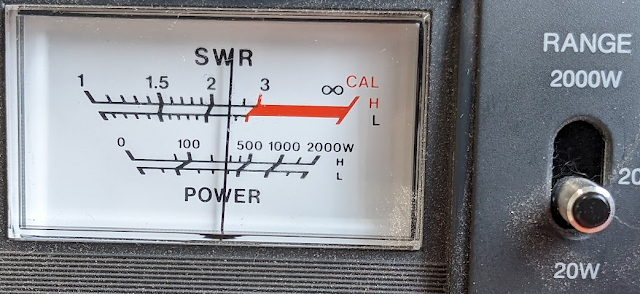
In keeping with our more is less theme, our key is homemade. I wrote an article about it that appeared in Sprat 195 this year! The homebrew nature of the keyer meant there were lots of possible root causes for what I was observing. Here's the radio's view of the mechanical portion of the keyer. The switch on the lower left is the one that was was causing resets.
Here's a view of the whole rig, battery (since replaced by a LiFePO4 of the same size), keyer, and Project TouCans mounted in the antenna over the backyard.
The key switch that caused resets is mounted on the right hand side of the keyer from this angle. The switch on top is the keyer programming button, the one below is—nominally—the dit switch of the iambic keyer.
Since I'd like the Tuna Topper amp of Project TouCans to run as much power as it can. I started to eliminate variables. The list of likely culprits as well as how one culprit—in some cases—led to another follow.
Dits are shorter than Dahs aren't they?
Since dit caused resets and dah didn't, maybe the shorter pulse width of a dit was causing the issue.
Experiment
Use the 'P' command of the Rockmite PicoKeyer to switch the keyer's dit and dah keys.Result
The switch that caused no resets with 'dah' now caused no reset with 'dit'. Meanwhile 'dah' on the other switch now caused a reset.Is there something special about the wire or switch?
I decided that it was likely that the switch or the wire it was attached to was somehow broken. To this end, I moved the switch's wire away from the headset audio output line in case they were feeding back on each other.
Experiment
I moved the wire from it's position on the Ethernet break-out board next to the headset wire to the opposite side of the 'dah ' key.
Result
Result: There was no effect.
I then posited that it had to be the switch.
Is the switch broken?
Experiment
Remove the switch, then simply test the bare wires together to make the connection for dahs—the same connection that was originally for dits.
Result
There was no change when I completed the circuit on the side of the keyer near the switch. There was a change—the keyer made very unhealthy sounding 'dah noises.' It wasn't great but it was working.
Is it a low quality connection?
Experiment and Result
I touched the switch wire that caused resets directly to the ground terminal on the Ethernet break out board. The results were worse. The keyer reset immediately.Does the rig secretly want a low quality connection?
I decided the radio preferred a bad connection and that the 'good' switch—the one that didn't reset the radio had a bad solder joint somewhere that was adding resistance between the keyer input and ground.Experiment
I added a 5 k resistor between the Ethernet breakout board line that had caused the resets and its switch.
Result
The keyer immediately functioned perfectly! I was able to turn up the amplifier bias so that Project TouCans was outputting almost 4 Watts before the keyer once again reset when running in straight key mode at which point the original 'good' keyer switch caused a reset while being used in straight key mode so that output power could be measured..
Next Steps
What'll I do next? Project TouCans is working well! I still think I'll see if the amp will give just a little more power width a 5 k resistor attached to the dah key.
Big Update
It appeared that the radio was having water issues this morning. Upon further inspection, I found that the original wire that was causing keyer resets had broken away from the RockMite board, and was randomly making other contacts. This may have been the issue all along! The wire has been fixed. At the same time, I added a 5 kohm resistor to the dah key switch path. The amplifier bias has been successfully adjusted to put the radio right at 4 Watts! To reach this level the transistor bias is set at 3.47 Volts.



Comments
Post a Comment
Please leave your comments on this topic: